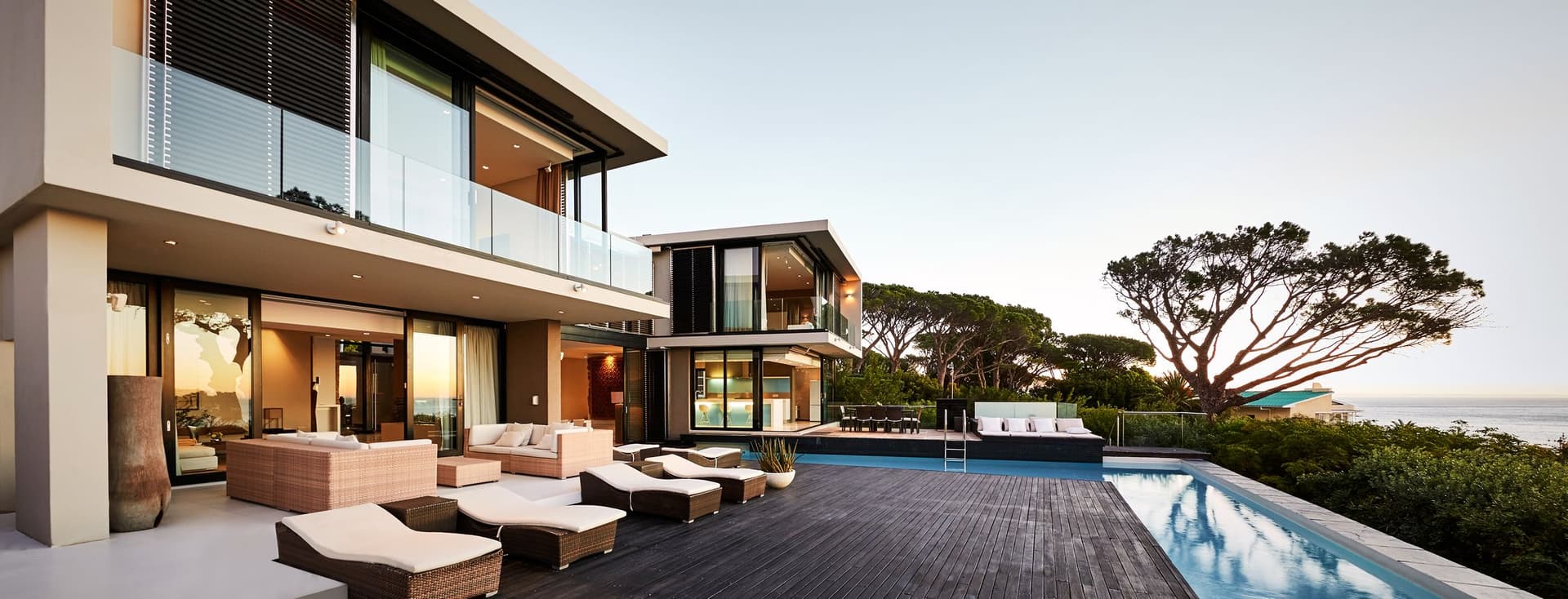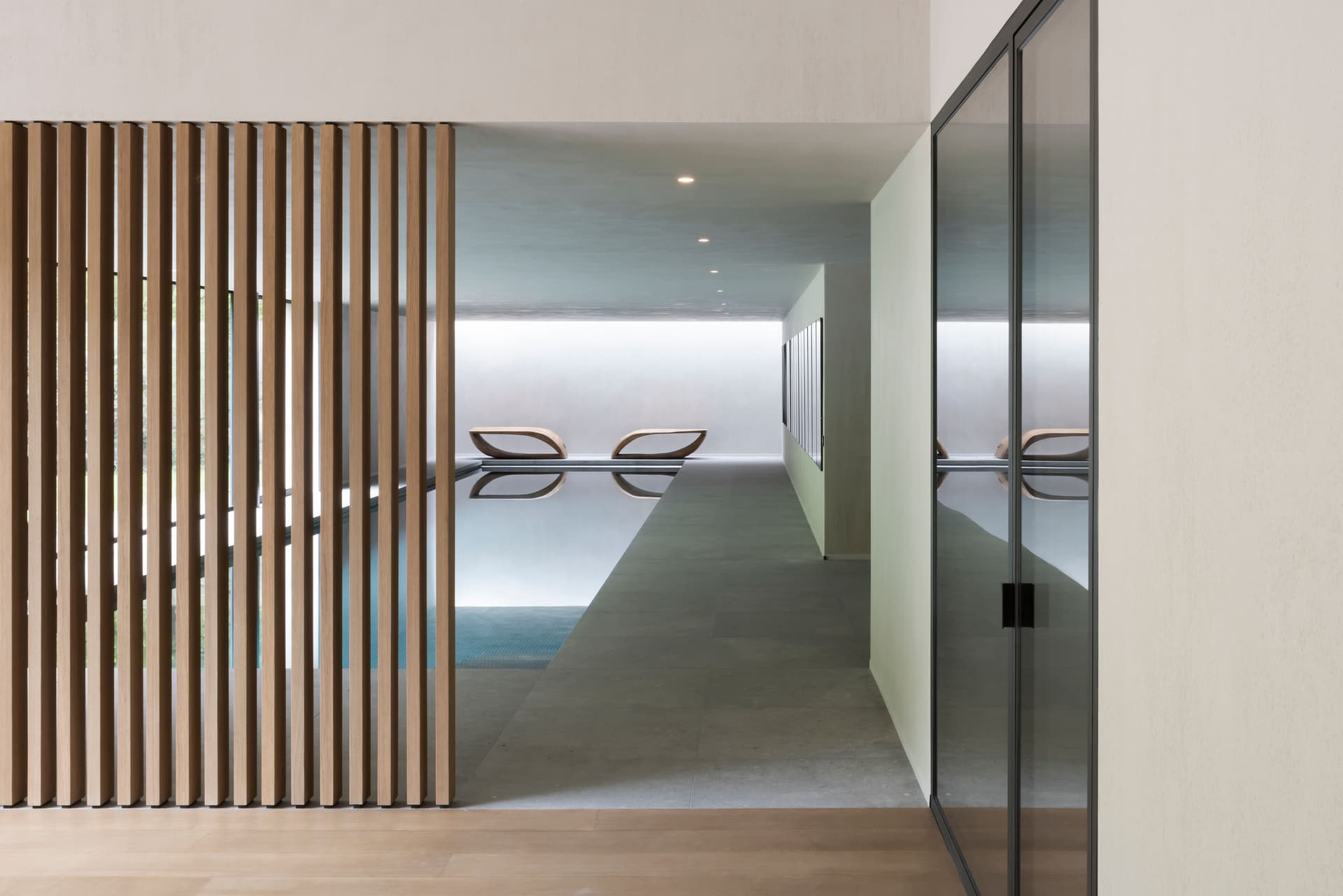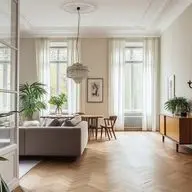
- 8 min read
- 18.08.2022
A house with pool

Many people dream of having a house with a pool. But what kind of pool is most suitable? An outdoor pool in your own garden for the summer is appealing because of the low acquisition costs. An indoor pool that can be used all year round, perhaps even extending into an outdoor pool, costs a lot more, as does a heated and covered outdoor pool. Is this investment worthwhile? How much does it cost to set up and maintain your own wellness area? Does every pool increase the value of the property?
Table of Content
To what extent does a pool increase the value of a property?
What types of pools are there?
Outdoor pool
Swimming pond
Indoor pool
Minipool
Above-ground pool
What materials are pools made of?
What does it cost to buy and maintain a pool?
How demanding is the maintenance of a pool?
How to make the house with pool safe for children?undefined
Who needs planning permission for a pool at or in the house?undefined
To what extent does a pool increase the value of a property?
Anyone looking for a new house is usually starting a new phase in their life and would like to fulfil their own lifestyle dream in doing so. A house with a pool appeals to almost everyone. So it's no surprise that properties with swimming pools are in high demand. Thus, depending on the region, size, design and type of pool, increases in value of between ten and 20 percent can be considered realistic. In the case of holiday properties, many prospective buyers expect a pool, which makes it easier to market the property. The prerequisite for such a high increase in value is that the pool is permanently and, above all, professionally installed. Generally speaking, the higher the quality and more visually appealing the design of the swimming pool, the higher the increase in value of the house. Especially in the wake of the pandemic, the desire to enhance the quality of living within one's own four walls has grown. A house with a pool is definitely a way to go and creates a pleasant holiday atmosphere in the garden.
What types of pools are there?
Once the decision has been made to have a pool, the next consideration is what it should look like. Apart from the acquisition costs, the different types of pools have an impact both on the useful life and the maintenance costs per year. An indoor pool requires sufficient space in the house. A swimming pond with plants that enhance the garden all year round is a more natural solution. In the case of an outdoor pool or a combination of outdoor and indoor pool, it is possible to significantly extend the useful life of the pool by adding an additional heater. Cast pools made of various plastics or GRP come in all sizes, different depths and straight or curved shapes. A masonry pool can be designed flexibly to meet special requirements in terms of shape and colour design.
Outdoor pool
In summer, an outdoor pool is the highlight of the garden. Depending on the size of the property, the number of people and personal preferences, the pool can be used by the whole family, complement the wellness area with the outdoor sauna or be used for sporting activities. People who enjoy swimming may choose a narrow, long pool to do their laps. Pools that slope downwards offer children the chance to play in the water and adults the opportunity to swim. While unheated outdoor pools are mainly usable in the warm season, heated swimming pools significantly extend the swimming season.
Swimming pond
A swimming pond on the property is completely natural and inexpensive to maintain. Beautiful plants replace the strong filters and pool cleaners that would otherwise be necessary and clean the water naturally. Properly installed, the bio-pool convinces with pleasant water that does not need any chlorine at all. The swimming pond is also a boon for the flora and fauna in the garden. However, the water temperature adapts to the outside temperature, as neither heating nor a cover or roof is possible. A swimming pond freezes over in winter when temperatures drop below zero. On the other hand, its appearance changes with the seasons and thus contributes a unique ambience to the garden design. A swimming pond therefore adds significant extra value to a property being sold.
Indoor pool
If there is enough space in the house, an indoor pool is the most exclusive choice of swimming pool. However, fitting an indoor pool in an existing property usually costs considerably more than an outdoor pool. In return, the in-house swimming pool can be used regardless of the weather with the utmost privacy from prying eyes. The indoor pool can be complemented by a sauna, rain shower and fireplace, for example, to create a comfortable wellness area. The high acquisition costs are compensated by a corresponding increase in the value of the property and an extraordinary quality of living.
Minipool
These small pools fit into every garden and even on terraces. Mini models are not suitable for swimming due to their shallow depth of 60 centimetres to one metre. However, they are great for relaxing and the children can play and splash around safely in the pool. Additional features such as lighting and splash showers transform the minipool into a real eye-catcher. A small pool can be made of different materials such as glass fibre reinforced plastic, PVC, aluminium or concrete.
Above-ground pool
Whether an above-ground pool should have steel walls or be made of plastic foil is a matter of personal preference. The mobile swimming pools do not cost a lot of money. Two people can quickly assemble the portable pools and, if necessary, quickly dismantle them again in winter to protect them from frost. The above-ground pool can be stored in the house, basement or garage during the winter months to save space. However, it does not increase the value of the property. On the other hand, the collapsible pool can be easily taken along when moving house and set up again on the new property. Yet the service life of this pool is significantly shorter than that of a permanently installed pool.
What materials are pools made of?
How long a pool lasts and how much maintenance it requires during its lifetime depends above all on the material chosen. This also affects the acquisition price. High-quality, reinforced plastics are usually more resistant to UV radiation and weather influences than cheaper variants. Masonry and concrete pools require excellent and professionally executed workmanship, but can be shaped into almost any individual form. A pool can also be made of the following materials:
GRP - glass fibre reinforced plastic
PVC laminated with glass fibre mats or in honeycomb composite system
Carbon ceramic - fibreglass with ceramic core
Polystone - artificial stone made of ultra-high-molecular copolymer, solid coloured
FPO - two plastic sheets made of flexible polyolefins with an insulating layer in between.
Durable polyester or temperature-resistant polypropylene
Steel-walled pool
Stainless steel or aluminium
Pond liner
Tiled reinforced concrete
Face concrete
System stone - steel-reinforced polystyrene filled with concrete
What does it cost to buy and maintain a pool?
Admittedly, a pool comes at a price. The acquisition costs for built-in swimming pools are considerable, depending on the size, shape, equipment and accessories, as well as the material chosen. While an above-ground pool can be had for as little as 200 euros, prices for a minipool start at 2,000 euros and for a concrete pool at 20,000 euros. While the acquisition costs can be lowered by building your own pool, you can quickly spend 50,000 euros depending on the size of the pool and the accessories. Typically, the annual maintenance for upkeep and electricity consumption is between 350 and 1,000 euros. If you want to heat the pool, you should budget 500 to 1,500 euros per year.
This is contrasted by the fun factor, the quick availability at the house, the privacy of using your own pool and, of course, the increase in the value of the property. A house with pool usually sells for significantly more than a comparable property without a swimming pool. Neither the acquisition costs nor the higher property value can be quantified across the board. They depend on various factors, as does the cost of regular upkeep and annual maintenance. These include, for example:
Pool size
Shape chosen: round, oval, rectangular, figure of eight or kidney shape, individual shape
Pool material
Base plate required
Scope of the installation work required
Pool insulation
Installation effort: indoor or outdoor pool
Location in the garden: protected between walls, in open space, covered
Weather impact: sun exposure, shading, wind
Contaminations: leaves, insects, sand, algae
Heated or not heated, type of heating (gas heating, solar or heat pump)
With or without pool cover, texture and shape of cover
Type of filter system: cartridge filter or sand filter
Skimmer, overflow system, cleaning robot
Water treatment: chlorine, active oxygen, salt
How demanding is the maintenance of a pool?
A pool needs to be maintained, whether it is small or large. Choosing the optimal location and a suitable filter system reduces the need for maintenance considerably. An undersized filter system reduces the initial acquisition costs, but increases the subsequent costs. When buying a pool, it is therefore better to choose a filter system that is too large than too small. A good quality sand filter cleans the water thoroughly and reduces the use of disinfectants such as chlorine or active oxygen. Accordingly, this also reduces the need to clean the walls and bottom of the pool.
A roof over the pool also protects against the weather. Pool covers serve a similar purpose and can be used as an alternative to heating and roofing. Thermal or solar foils increase the water temperature by a few degrees. Electric pool covers are more luxurious, as they protect the pool like a horizontal roller shutter at the touch of a button. This significantly reduces insects, leaves and algae. The more rigid pool covers can be walked on and thus increase safety. They also protect against contamination from leaves and insects, reduce the formation of algae and lower heating costs.
There are affordable accessories for cleaning the pool manually. Nets collect leaves, brushes clean the walls. Triangular cleaning brushes clean even the deepest corners of rectangular pools. A pool robot cleans the swimming pool completely independently. You can get inexpensive models from 50 euros that clean the pool floor, while high-quality robots can even cost a few thousand euros.

How to make the house with pool safe for children?
A swimming pool in the garden is particularly appealing for children, be it your own or those of the neighbours. The duty to protect the public prescribes that even private properties must be safe and secure, even in the event of trespassing. Therefore, when buying a pool, it is important to pay attention not only to bathing fun, but also to safety. To prevent children and pets from drowning, appropriate installations are required on or around the pool.
Sturdy pool covers are available in various designs. Raised sliding covers or walk-on pool covers prevent unwanted pool access. Solar foils, on the other hand, are not sufficient as a child safety feature, as they tend to conceal the danger even more. Special safety foils are extra stable and have tie-downs so that the foil does not collapse when stepped on. An alternative to a walk-on or stable cover is a pool fence. There are special designs for this purpose that cannot be opened easily by children and also keep pets out.
Special tiles at the edge of the pool prevent people and animals from slipping and thus from accidentally falling into the water. A pool alarm with an acoustic signal indicates when the water level changes caused by a submerged body. Motion detectors, bracelets for children, collars for dogs or floating alarms are all only complementary measures. A fence or a secure cover are the first choice methods to pet-proof or child-proof a house with a pool.
Who needs planning permission for a pool at or in the house?
Pools with a capacity of up to 50 cubic metres generally do not require planning permission in Germany. Anything above this limit is governed by the building laws of the respective federal state, stipulating whether or not building permission is required. In the case of swimming pools, most state governments refer to the model building code, which allows pools with a pool capacity of 100 cubic metres in section 61 paragraph 10a of the German Building Code (MBO). That should be enough for a house with a pool in most cases. Information on regional statutory regulations can be obtained from the local building authority in the vicinity of the property.
Nevertheless, even pool installations below this threshold actually require a building notification to be submitted to the building authority. In most cases, a drawing of the property, the intended location of the pool and informative photos are sufficient for this purpose. Usually, a building permit is granted without any difficulties. After completion of the swimming pool, the building authority expects a brief building completion report. This is all it takes in terms of bureaucracy. The construction of an indoor pool or an outdoor pool with a roof always requires prior planning permission, regardless of the size. In the case of an indoor swimming pool, the appropriate statics of the building must also be taken into account. When in doubt, an architect can check this. By the way, mobile above-ground pools can be set up anywhere around the house without prior permission.
You may also be interested in
 Floor plan: Everything important about planning, creation, and interpretation
Floor plan: Everything important about planning, creation, and interpretation Sustainability & ESG in Real Estate: What You need to know
Sustainability & ESG in Real Estate: What You need to know- 3 min.
- 30.04.2025
 Living in green surroundings: north-east Hamburg in high demand
Living in green surroundings: north-east Hamburg in high demand&w=1920&q=75) New Energy as the Key to Future-Proof Real Estate
New Energy as the Key to Future-Proof Real Estate- 5 min.
- 23.05.2025
 Individual renovation roadmap
Individual renovation roadmap Engel & Völkers cooperates with service provider Enter: Energy advice for homeowners in Germany
Engel & Völkers cooperates with service provider Enter: Energy advice for homeowners in Germany&w=1920&q=75) Dubai property prices: Demand drives prices up
Dubai property prices: Demand drives prices up- 4 min.
- 27.09.2024
 Zurich real estate prices: Stable market, high demand
Zurich real estate prices: Stable market, high demand- 5 min.
- 16.12.2024
Contact
Contact your personal advisor


Engel & Völkers Germany
Vancouverstraße 2a
20457 Hamburg, Germany
Tel: +49 40 361310